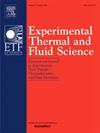Design and validation of an air-bearing-based micro skin-friction balance for small area samples
IF 2.8
2区 工程技术
Q2 ENGINEERING, MECHANICAL
Experimental Thermal and Fluid Science
Pub Date : 2025-02-14
DOI:10.1016/j.expthermflusci.2025.111433
引用次数: 0
Abstract
Skin friction, or wall shear stress is a fundamental parameter for characterizing turbulent boundary layer (TBL). Among various methods, the floating element (FE) method has long been advocated and developed. However, accurately measuring WSS for small-area samples remains challenging. This paper proposes air-bearing-based high-resolution micro skin-friction balance and a corresponding sliding-covering measurement method. As an extension of the traditional flush-mounted FE measurement method, it reduces errors caused by the edge gap and gap flow of the floating elements, and employs a clamping mechanism for high-precision assembly, thereby enhancing the measurement efficiency and accuracy for small-area samples. The error sources in balance calibration and measurement were carefully analyzed, with corresponding uncertainty calculated. The measurement range and resolution are and , respectively. For a smooth surface, assume the measured force is , and the measurement precision is approximately . The balance is validated using a smooth-wall zero-pressure-gradient TBL. The measured skin-friction coefficient, , generally follows a Coles–Fernholz relation within (with chosen constant of and ) for a momentum-thickness-based Reynolds number . Additionally, the skin friction on the surfaces of two envelope materials (EMs) used for airships was measured using the sliding-covering method. The results were compared with those of a smooth surface, revealing that the outer surfaces of EMs exhibited a drag reduction effect at low Reynolds numbers, with further potential for improvement in a broader range of Reynolds numbers. The balance measured the skin-friction differences between samples and revealed that the roughness of the samples affected the precision of the measurements. As a direct measurement method, the results have higher reliability.
基于空气轴承的小面积试样微摩擦平衡的设计与验证
表面摩擦或壁面剪切应力是表征湍流边界层(TBL)的基本参数。在各种方法中,浮元法(FE)一直是人们提倡和发展的方法。然而,精确测量小面积样品的WSS仍然具有挑战性。提出了基于空气轴承的高分辨率微摩擦平衡及相应的滑动覆盖测量方法。作为传统平装式有限元测量方法的延伸,它减少了由浮动元件边缘间隙和间隙流动引起的误差,并采用夹紧机构进行高精度装配,从而提高了小面积样品的测量效率和精度。仔细分析了天平标定和测量中的误差源,并计算了相应的不确定度。测量范围为±0.12N,分辨率为2.5×10−7N。对于光滑表面,假设测得的力为1×10−4N,测量精度约为0.047%。使用光滑壁零压力梯度TBL验证平衡。对于基于动量-厚度的雷诺数Reθ=1050 ~ 3361,测量的皮肤摩擦系数Cf≡τ θ w/q∞,通常遵循Coles-Fernholz关系Cf=21/κ lnreθ +C−2在3%范围内(选择常数κ=0.384和C=4.12)。此外,采用滑动覆盖法测量了两种飞艇用包壳材料(EMs)的表面摩擦。将结果与光滑表面的结果进行了比较,结果表明,在低雷诺数下,EMs的外表面表现出减阻效果,并且在更大的雷诺数范围内具有进一步改善的潜力。天平测量了样品之间的表面摩擦差异,并揭示了样品的粗糙度影响测量的精度。作为一种直接测量方法,测量结果具有较高的可靠性。
本文章由计算机程序翻译,如有差异,请以英文原文为准。
求助全文
约1分钟内获得全文
求助全文
来源期刊

Experimental Thermal and Fluid Science
工程技术-工程:机械
CiteScore
6.70
自引率
3.10%
发文量
159
审稿时长
34 days
期刊介绍:
Experimental Thermal and Fluid Science provides a forum for research emphasizing experimental work that enhances fundamental understanding of heat transfer, thermodynamics, and fluid mechanics. In addition to the principal areas of research, the journal covers research results in related fields, including combined heat and mass transfer, flows with phase transition, micro- and nano-scale systems, multiphase flow, combustion, radiative transfer, porous media, cryogenics, turbulence, and novel experimental techniques.
 求助内容:
求助内容: 应助结果提醒方式:
应助结果提醒方式:


